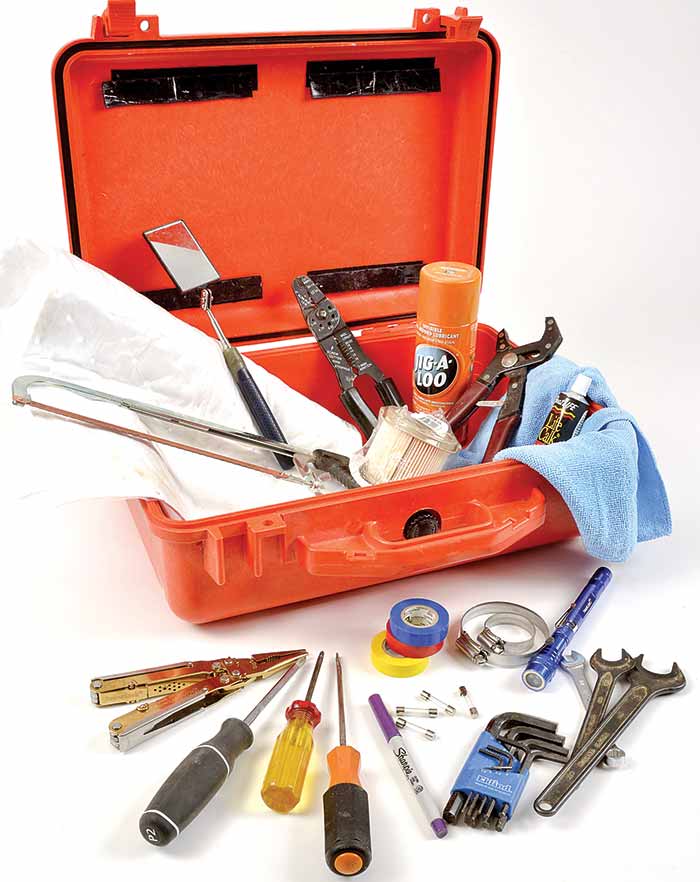Advertisement
Having a few basic tools on the boat can salvage a day on the water. Start with our list of essentials.

Photo: Mark Corke
When your boat breaks down, having a basic toolkit on board could make the difference between a minor irritation and pulling the plug on the day and calling for a tow. Although it's difficult to plan for every eventuality, being ready with some basic tools could make you a hero. This is not a comprehensive toolkit, but simply a basic compendium of tools for first-aid maintenance. You'll likely have a few ideas of your own, so start with these basics and build from there.
Tip
1. Mirror on a stick: Enables you look into places that would otherwise be inaccessible.
2. Pliers: Perfect for tasks such as removing cotter pins from the propeller nut, and for other times that require a firm grip. Also add needle nose, water pump, and vice-grip pliers.
3. Fuel filter: So it's not really a tool, but its vital to the health and well-being of your boat engine. You should always have at least one spare handy. You might want to include an onboard engine prefilter and water separator filter if these are fitted to your boat.
4. Hacksaw: Not just for cutting metal, it can also saw through wood and fiberglass in a pinch.
5. Caulking: Great for temporary fixes of leaking deck fittings. Can be purchased in an assortment of colors, so pick one to suit your boat finish. Some cure underwater.
6. Multi-tool: If you carry only one tool, then a good multi-tool should be it. Includes pliers, file, screwdrivers, knife, small saw, and seemingly a tool for every problem.
7. Rags: You'll never regret keeping a selection of rags on board to make cleaning up messes a snap. Microfiber cloths are the perfect choice for wiping down chartplotters and instrument displays without damage.
8. Oil-absorbent pads: Helps prevent oil and fuel spills from finding their way into the bilge, or the water.
9. Spray lubricant: Can be used for everything from freeing corroded fasteners to spraying a protective film on the engine. Follow manufacturer recommendations.
10. Wire strippers/crimping tool: Hopefully you won’t be doing any heavy-duty wiring jobs offshore, but a set of wire cutters with a built-in crimping tool and a few spare crimp connectors means you can always make lasting connections.
11. Flashlight: Essential for finding that errant nut and washer that you just dropped into the bilge.
12. Wrenches: At the very least, stash the wrenches that came with the motor onboard. You might want to add a couple of other frequently used sizes. An adjustable wrench is handy, too, but can be a tight fit in many places.
13. Allen wrenches: These come in both metric and standard sizes. Choose the type that fits your engine.
14. Hose clamps: Again, not really a tool, but they take up so little space in the toolbox that it seems silly not to have a few, and they could save your day if one fails. Bonus: A large hose clamp tightened around a spin-on filter can provide extra grip, but don't cut your hands.
15. Adhesive tape: There are literally thousands of uses for tape. I once sailed all the way across the Atlantic with the head held in position with duct tape!
16. Fuses: A blown engine fuse could be all that’s preventing your engine from cranking over or your VHF from turning on. Make sure you carry a selection of sizes. Check your owner’s manual; you may require a size or type that's particular to your engine. Blown fuses may mean an electrical problem, so address it when back at the dock. And never use a fuse with a higher rating than what you’re replacing because it could damage the circuit.
17. Marker: Good for myriad uses, from marking the change date on fuel filters to permanently labeling cables.
18. Screwdrivers: Carry a mix of sizes in both flathead and Phillips styles. Don't forget stubby ones for confined areas.
19. Toolbox: The extra money spent for a good waterproof toolbox is never wasted. It'll keep your valuable tools dry, in one place, and prevent them from corroding.
20. Nut drivers: This screwdriver-type of tool is designed for tightening nuts and bolts without a ratchet. Carry some of the most-used sizes in both standard and metric.
21. Multimeter: Indispensable for tracking down electrical faults, tracing live circuits, and testing the state of charge of the battery.
22. Hammer: A small ball-peen hammer takes up little room in the toolbox. Good for everything from getting an ornery fastener to move to cracking lunchtime walnuts.
23. Magnetic retriever: Drop a screw or other fastener in the bilge, and you’ll be glad that you included this in the toolbox.
24. Disposable gloves: Keep grease and dirt off your hands, then just peel them off your clean hands.
Read this article to learn what tools you should keep in your vehicle for roadside repairs.
